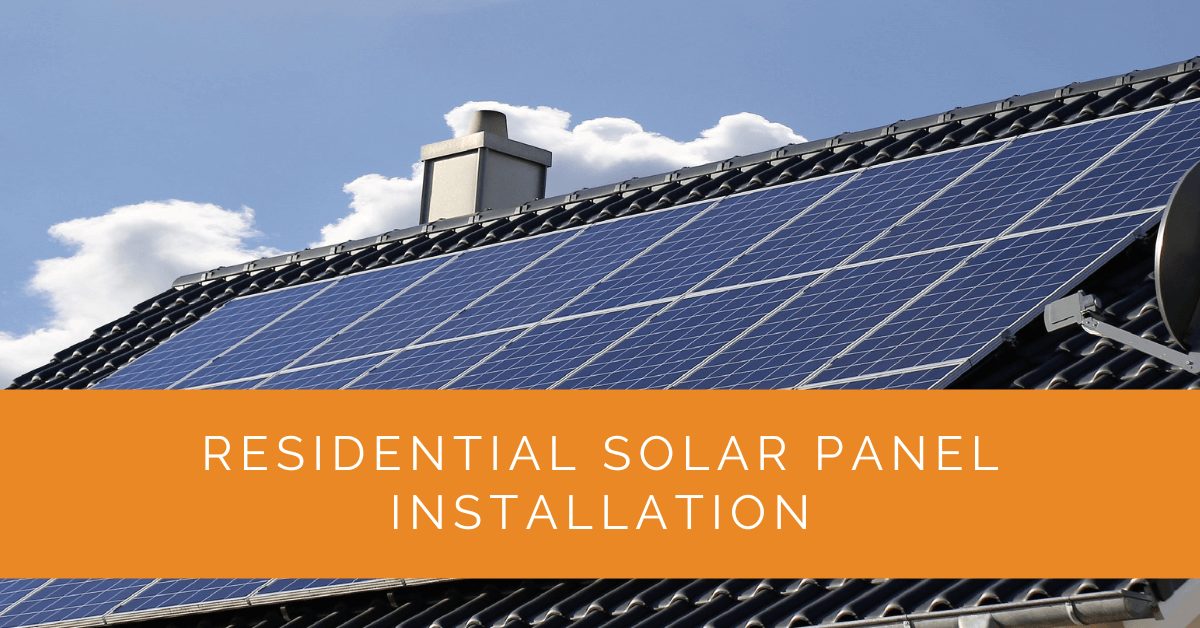Solar energy has gained tremendous popularity in recent years, and for good reason. It’s clean, renewable, and can significantly reduce your energy bills. Harnessing the sun’s power by installing solar panels on your residential property is environmentally responsible and a wise financial investment. This guide will walk you through the entire solar panel installation process, from system design to obtaining permits and everything in between. Whether you’re considering a DIY solar project or hiring a professional solar installation company, we’ve got you covered. Join us on this journey to understand the ins and outs of residential solar panel installation and take a significant step towards a greener and more sustainable future.
Contents
- 1 Key Takeaways
- 2 Getting Started with Solar Panel Installation
- 3 DIY vs. Professional Installation
- 4 The Solar Panel Installation Process
- 5 Solar Panels on Your Roof
- 6 Case Study: DIY vs. Professional Solar Panel Installation
- 7 Expert Insights From Our Solar Panel Installers About Residential Solar Panel Installation
- 8 Experience Solar Excellence with Us!
- 9 Conclusion
Key Takeaways
- Choosing between DIY and professional solar panel installation depends on expertise, time, and budget. Professionals offer efficiency and warranty protection, while DIY can save costs but requires skill and time.
- The solar panel installation process involves system design, permits, and meticulous steps like roof inspection, panel mounting, electrical work, and even integrating solar batteries for energy storage.
- Solar panels integrated into your roof offer aesthetic appeal and space efficiency, but regular maintenance, including cleaning, monitoring, and professional inspections, is essential to ensure optimal performance and longevity.
Getting Started with Solar Panel Installation
Understanding Solar Energy
Before diving into the installation process, grasping solar energy fundamentals is crucial. Solar panels, or photovoltaic (PV) panels, are designed to capture sunlight and convert it into electricity. This process involves solar cells containing semiconductors that absorb photons from the sun and release electrons, creating an electric current. The more solar panels you install, the more energy you can generate.
Solar energy is environmentally friendly and a valuable power source for your home. By installing solar panels, you can reduce your carbon footprint and contribute to a cleaner and greener planet.
DIY vs. Professional Installation
When it comes to installing solar panels on your residential property, one of the initial decisions you must make is whether to embark on a DIY (Do-It-Yourself) installation or enlist the services of a professional solar installation company. This pivotal choice can significantly impact your solar power system’s success, safety, and efficiency. In this section, we will explore both options in detail, weighing the pros and cons to help you make an informed decision.
DIY Solar Panel Installation
Advantages of Going the DIY Route
- Cost Savings: One of the most compelling reasons people consider DIY solar panel installation is the potential for cost savings. You can eliminate labor costs associated with professional installation services by handling the installation yourself. However, weighing these savings against the potential risks and challenges is crucial.
- Sense of Accomplishment: Successfully installing solar panels can be a gratifying experience. It allows you to take a hands-on approach to your energy transition, and many homeowners find this aspect rewarding.
Factors to Consider with DIY Installation
- Expertise and Skill: DIY solar panel installation demands electrical work, roofing, and construction expertise. You’ll need to be comfortable working with electrical components and understand local building codes well. If you lack these skills, DIY installation may not be advisable.
- Time Commitment: Installing solar panels is a time-consuming process. You’ll need to set aside several days or even weeks, depending on the size and complexity of your system. Consider whether you have the time and patience to complete the project.
- Warranty Implications: It’s essential to know that DIY installations may void equipment warranties. Most solar panel manufacturers and suppliers require professional installation to maintain warranty coverage. Losing warranty protection could be a costly trade-off for DIY savings.
Hiring a Professional Solar Installation Company
Advantages of Professional Installation
- Expertise and Experience: Professional installers are trained and certified to handle all aspects of solar panel installation. They possess the knowledge and experience to ensure a safe and effective installation. This expertise reduces the likelihood of errors affecting your system’s performance.
- Efficiency: Professional installers can complete the installation more quickly and efficiently. Their experience allows them to navigate potential challenges smoothly, reducing downtime and minimizing disruptions to your daily life.
- Warranty Protection: Most professional installations come with warranties, ensuring the longevity and performance of your solar energy system. This warranty protection provides peace of mind and safeguards your investment.
Factors to Consider with Professional Installation
- Cost: The primary drawback of professional installation is the cost. You will incur labor expenses and solar panels and equipment costs. However, many homeowners find that the long-term benefits outweigh the upfront expenses.
- Choosing the Right Installer: Not all solar installation companies are created equal. Researching and selecting a reputable installer with a track record of successful installations and satisfied customers is essential. Obtain multiple quotes and thoroughly vet potential installers to make an informed choice.
The decision between DIY and professional solar panel installation hinges on various factors, including your expertise, available time, budget, and risk tolerance. While DIY installation may offer cost savings and a sense of achievement, it’s essential to recognize the potential challenges and warranty implications. On the other hand, professional installation ensures expertise, efficiency, and warranty protection but comes at a higher upfront cost. We recommend evaluating your specific circumstances, consulting with solar experts, and carefully weighing the pros and cons to determine the best approach for your residential solar project.
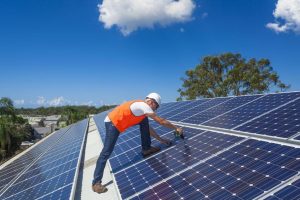
The Solar Panel Installation Process
Now that you’ve explored the options between DIY and professional installation let’s delve into the intricacies of the solar panel installation process. This step-by-step guide will provide a comprehensive understanding of what to expect when installing solar panels on your residential property.
System Design and Planning
Determine Your Energy Needs
Before you can embark on the physical installation of solar panels, you must engage in meticulous system design and planning. This crucial step involves assessing your home’s energy needs and tailoring your solar energy system accordingly. Here’s what you need to consider:
- Energy Consumption Analysis: Begin by analyzing your historical energy consumption. Review your past electricity bills to understand your household’s typical energy usage patterns throughout the year.
- Location and Solar Potential: Evaluate your geographical location and its solar potential. Factors such as your region’s solar radiation levels, climate, and local shading effects can influence your system’s design and performance.
- Orientation and Tilt: Determine your solar panels’ optimal orientation and tilt angle. In most cases, panels should face south to maximize sunlight exposure. However, east and west-facing panels can also be effective, depending on your energy consumption patterns.
Solar Panel Placement
The placement of your solar panels plays a pivotal role in maximizing energy production. During this phase, you’ll decide where and how to position your panels to harness the maximum sunlight. Consider the following:
- Roof Analysis: Examine your roof’s structure and condition. A professional installer will assess whether your roof can support the weight of the solar panels and ensure it’s in good repair.
- Mounting System: Select the appropriate mounting system or racking system for your solar panels. Proper mounting ensures stability and longevity. Various options are available, such as roof mounts, ground mounts, and tracking systems.
Inverter Selection
Solar panels generate direct current (DC) electricity, which needs to be converted into alternating current (AC) for use in your home. The choice of solar inverter is critical in this regard, as it directly impacts your system’s efficiency. Here are the two primary types:
- String Inverters: These connect multiple solar panels in a series (string) and are a cost-effective option. However, they can be prone to performance degradation if one panel is shaded or experiences an issue.
- Microinverters: Microinverters are installed on each solar panel, allowing them to operate independently. This minimizes the impact of shading or panel malfunctions and can lead to higher system efficiency.
Obtaining Permits
Once your solar energy system is designed and planned, you’ll need to navigate solar panel installation’s regulatory and permitting aspects. This step ensures your installation complies with local building codes and safety standards.
Contact Your Local Utility Company
Before applying for permits, contact your local utility company to discuss your solar installation plans. They can provide crucial information about net metering programs and specific guidelines for connecting your solar system to the grid. Net metering allows you to earn credits for the excess energy your system produces, which you can use during periods of lower solar generation.
Building Permits
Most jurisdictions require a building permit for your solar panel installation. This permit ensures that your system meets local building codes and safety standards. You’ll typically need to submit detailed plans and specifications for approval before commencing installation.
Permission to Operate (PTO)
Once your solar panels are installed and inspected, you’ll need permission to operate (PTO) from your utility company. PTO authorizes your system to connect to the grid and generate solar power. It’s a critical step that ensures your system is safely integrated into the electrical infrastructure.
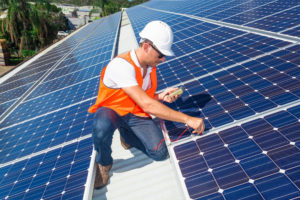
Solar Panel Installation Steps
With permits in hand and a well-designed solar system, you’re ready to proceed with the physical installation of your solar panels. This step-by-step guide outlines the installation process:
Step 1: Roof Inspection and Mounting
Before mounting solar panels, a professional installer will conduct a thorough roof inspection. This assessment ensures that your roof can safely support the additional weight of the solar panels. During this phase:
- Structural integrity is assessed to identify any repairs or reinforcements needed.
- Roof mounts or racking systems are securely attached to the roof’s surface, providing a stable foundation for the panels.
Step 2: Solar Panel Mounting
Solar panels are then carefully mounted onto the racking system. Experienced installers position the panels to optimize sunlight exposure throughout the day. Securely fastened to withstand various weather conditions, the panels are meticulously arranged to maximize energy production.
Step 3: Electrical Work
The heart of your solar energy system lies in the electrical components. During this phase:
- Solar inverters, selected based on your system’s design, are installed to convert the DC electricity generated by the panels into usable AC electricity for your home.
- Wiring and electrical connections are made to integrate the solar energy system seamlessly with your household electrical system.
Step 4: Solar Battery Integration
Incorporating solar batteries into your system is a smart way to maximize the benefits of your solar panels. Solar batteries store excess electricity generated by your panels during the day, allowing you to use them during the evenings or when sunlight is limited. Here’s why solar batteries are a valuable addition:
- Energy Storage: Solar batteries store surplus energy, ensuring that you have a reliable power source even when the sun isn’t shining. This can help reduce your grid dependence and lower your energy bills.
- Grid Independence: With solar batteries, you can achieve energy independence by using stored energy during power outages or periods of high electricity demand when utility prices peak.
- Optimized Self-Consumption: Solar batteries enable you to maximize the self-consumption of your panels’ energy. Excess energy is stored for later use, reducing the electricity you need to purchase from the grid.
Solar batteries come in various sizes and types, and your choice will depend on your energy needs and budget. When integrated into your solar panel system, they can enhance your overall energy efficiency and resilience.
Step 5: Final Inspection and Testing
With the physical installation complete, a final inspection is conducted to ensure that everything complies with safety and code requirements. This critical step encompasses the following:
- Reviewing the entire installation to ensure it adheres to local regulations.
- Verifying that the electrical connections are secure and functioning correctly.
- Testing the system to confirm that it’s producing electricity as expected.
Once the final inspection passes, your solar panel system is ready to generate clean and renewable energy for your home.
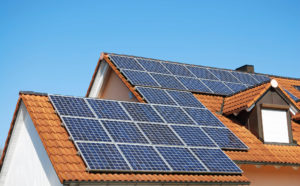
Solar Panels on Your Roof
Now that we’ve covered the intricacies of the solar panel installation process let’s shift our focus to an increasingly popular and aesthetically pleasing option: integrating solar panels into your roof. This section will delve into the concept of solar roof integration, its benefits, and the maintenance required to ensure your solar panels continue to perform at their best.
Solar Roof Integration
Aesthetics and Seamlessness
Solar roof integration, often referred to as a solar roofing system, blends the functionality of solar panels with the aesthetic appeal of your existing roof. Unlike traditional solar panels mounted on racks, solar roofing materials incorporate photovoltaic technology into roofing materials such as shingles or tiles. The result is a seamless and visually pleasing solar solution that enhances your home’s curb appeal.
Types of Solar Roofing Materials
- Solar Shingles: Solar shingles, or solar roof tiles, resemble traditional roofing materials but contain integrated solar cells. They come in various styles and colors, allowing you to match your solar roofing system with your home’s design.
- Solar Tiles: Solar tiles are similar to solar shingles but offer different design options. Some solar tiles mimic the appearance of traditional roof tiles, while others have a more contemporary aesthetic.
- Solar Panels with Roof Integration: Some manufacturers offer solar panels specifically designed for roof integration. These panels are thinner and sleeker than traditional solar panels, providing a more streamlined appearance when installed.
Benefits of a Solar Roof
Solar roofs offer numerous advantages beyond their aesthetic appeal:
- Enhanced Durability: Solar roofing materials are designed to withstand the elements, including harsh weather conditions. They are often more durable than standard roofing materials and can last decades.
- Space Utilization: Solar shingles or tiles cover a larger area than traditional solar panels, maximizing energy production while using available roof space most efficiently.
- Energy Efficiency: Solar roofing systems are typically more energy-efficient due to their integrated design. The seamless integration reduces energy losses associated with wiring and connections.
- Incremental Installation: Solar roofing systems can be installed incrementally, allowing you to expand your solar capacity as needed or as your budget permits.
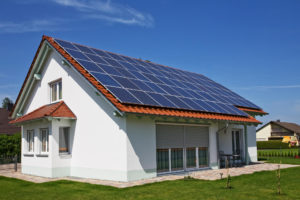
Maintenance and Upkeep
Regular maintenance and upkeep are essential to ensure your solar roofing system continues to generate clean and renewable energy efficiently. Here’s what you need to know:
Cleaning
Regular cleaning is crucial to remove dust, dirt, leaves, and other debris that can accumulate on the surface of your solar roofing materials. A clean surface ensures optimal sunlight absorption and energy production. Depending on your location and the prevalence of debris, cleaning may be required several times a year.
Monitoring
Many solar roofing systems have built-in monitoring systems that allow you to track your system’s performance remotely. These systems provide real-time data on energy production, making it easier to detect any issues or declines in performance. Monitoring can help you identify and address problems promptly.
Professional Inspections
It’s advisable to schedule annual inspections by a qualified solar technician to ensure your solar roofing system is functioning optimally. During these inspections, the technician will:
- Examine the condition of the roofing materials, including solar shingles or tiles, for any signs of damage or wear.
- Check electrical connections and wiring to ensure they are secure and functioning correctly.
- Conduct performance tests to verify that the system generates the expected amount of electricity.
By conducting regular inspections, you can extend the lifespan of your solar roofing system and maximize its energy production.
Solar panels integrated into your roof offer both aesthetic and functional benefits. Solar roofing materials seamlessly blend into your home’s design while providing a renewable energy source. However, it’s crucial to understand the maintenance requirements to keep your solar roofing system in top shape. Regular cleaning, monitoring, and professional inspections are key to ensuring the longevity and efficiency of your solar panels integrated into your roof.
Case Study: DIY vs. Professional Solar Panel Installation
The Solar Journey of the Thompson Family: DIY vs. Professional Installation
Background
The Thompson family, residing in sunny San Diego, California, transitioned to solar energy to reduce their electricity bills and their environmental footprint. They owned a typical suburban home with a south-facing roof, perfect for solar panels. Faced with the choice of DIY installation or hiring a professional, they sought advice from Solar Panels Network USA.
Objective
The goal was to determine the most suitable installation approach for the Thompson family, considering their technical skills, budget, and desire for a seamless experience.
Analysis and Consultation
DIY Solar Panel Installation
- Advantages:
- Cost Savings: Mr Thompson, a handyman, was excited about the potential savings of eliminating labour costs.
- Personal Satisfaction: Successfully installing the panels would be a rewarding project for him.
- Challenges:
- Technical Expertise: While Mr. Thompson was handy, he lacked specific experience with electrical work and roofing, which posed a risk of errors.
- Time Commitment: The installation would require significant time, potentially taking several weekends.
- Warranty Risks: DIY installation could void the manufacturer’s warranty, posing a financial risk if issues arose.
Professional Solar Panel Installation:
- Advantages:
- Expertise and Efficiency: Professional installers have the necessary experience and certification to ensure a safe and efficient installation.
- Warranty Protection: Professional installation would maintain the manufacturer’s, providing peace of mind.
- Time Savings: Professionals could complete the installation quickly, allowing the Thompsons to start saving on their electricity bills sooner.
- Challenges:
- Higher Upfront Cost: The primary drawback was the additional cost of labor, increasing the overall project expense.
Decision-Making Process
The Thompsons carefully weighed the pros and cons carefully. They valued the long-term performance, warranty protection, and peace of mind offered by professional installation over the potential cost savings of a DIY approach.
Installation and Results
The Thompsons chose to hire Solar Panels Network USA for the installation. The company installed a 5kW system with high-efficiency monocrystalline panels. The process included:
- Roof Inspection and Mounting: The team conducted a thorough inspection and securely mounted the panels.
- Electrical Work: Certified electricians ensured safe and compliant connections.
- Final Inspection and Testing: The system passed all inspections and was operational within two days.
Results:
- Energy Efficiency: The system reduced their electricity bills by 75%, exceeding expectations.
- Aesthetic Satisfaction: The installation was neat and professional, maintaining the home’s architecture.
- Maintenance: The system required minimal maintenance, providing long-term reliability.
Summary
The Thompson family’s family highlights the importance of evaluating both DIY and professional installation options. By choosing professional installation, they benefited from expertise, efficiency, and warranty protection by choosing professional installation, ensuring a high-performing solar energy system with minimal hassle. This case study underscores the value of consulting with solar experts to make informed decisions tailored to individual needs and circumstances.
Expert Insights From Our Solar Panel Installers About Residential Solar Panel Installation
Residential solar panel installation is more than just placing panels on a roof. Each step, from system design to final inspection, requires careful planning and expertise. Ensuring the panels are correctly oriented and securely mounted is crucial for maximizing energy output and system longevity.
Choosing between DIY and professional installation can be tough. While DIY offers cost savings, professional installation provides peace of mind with warranties and expert handling of electrical and structural aspects. This guarantees safety and efficiency.
Experience Solar Excellence with Us!
Trust in Solar Panels Network USA, where our seasoned experts deliver top-quality solar solutions for homes and businesses nationwide. With a legacy of countless successful installations and a commitment to sustainable energy, we’re your reliable partner in the solar journey. Ready for a brighter, eco-friendly future? Call us now at (855) 427-0058 and harness the power of the sun!
Conclusion
Residential solar panel installation is a viable and environmentally friendly way to power your home with solar energy. Understanding the installation process is crucial whether you install solar panels yourself or hire a professional installer. By following the step-by-step guide and obtaining the necessary permits, you can harness the sun’s power and enjoy the benefits of a clean and sustainable energy source. Don’t hesitate to contact our team for expert advice and assistance on your solar journey.
As experts in the field, we’re dedicated to helping homeowners like you make informed decisions about solar energy. Contact us today to get started on your solar project and take a significant step towards reducing your energy bills and carbon footprint. Let’s work together to create a brighter and greener future.
About the Author
Solar Panels Network USA stands at the forefront of solar energy solutions, driven by a team of seasoned solar engineers and energy consultants. With over decades of experience in delivering high-quality solar installations and maintenance, we are committed to promoting sustainable energy through customer-centric, tailored solutions. Our articles reflect this commitment, crafted collaboratively by experts to provide accurate, up-to-date insights into solar technology, ensuring our readers are well-informed and empowered in their solar energy decisions.

